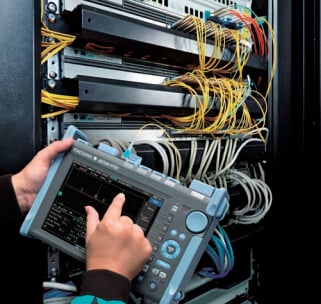
OTDR (Optical Time Domain Reflectometer), as one of the important fiber optic testers, is most commonly used by technicians or
installers to certify the performance of new fiber optic links and detect the issues of existing fiber links. There are some
specifications of an OTDR which may affect its performance. To understand these specifications can help users get maximum
performance from their OTDRs. Today, one of the key specifications—Dead Zone will be introduced here.
Definition of Dead Zones
The OTDR dead zone refers to the distance (or time) where the OTDR cannot detect or precisely localize any event or artifact
on the fiber link. It is always prominent at the very beginning of a trace or at any other high reflectance event.

Why Is There a Dead Zone?

In simple terms, OTDR dead zone is caused by a Fresnel reflection (mainly caused by air gap at OTDR connection) and
the subsequent recovery time of the OTDR detector. When a strong reflection occurs, the power received by the
photodiode can be more than 4,000 times higher than the backscattered power, which causes detector inside of OTDR
to become saturated with reflected light. Thus, it needs time to recover from its saturated condition. During the
recovering time, it can not detect the backscattered signal accurately which results in corresponding dead zone
on OTDR trace. This is like when your eyes need to recover from looking at the bright sun or the flash of a camera.
In general, the higher the reflectance, the longer the dead zone is. Additionally, dead zone is also influenced by
the pulse width. A longer pulse width can increase the dynamic range which results in a longer dead zone.
Types of Dead Zones
In general, there are two types of dead zones on an OTDR trace—event dead zone (EDZ) and attenuation dead zone (ADZ).

Event Dead Zone
The event dead zone is the minimum distance between the beginning of one reflective event and the point where a
consecutive reflective event can be detected. According to the Telcordia definition, event dead zone is the location
where the falling edge of the first reflection is 1.5 dB down from the top of the first reflection.

Attenuation Dead Zone
The attenuation dead zone is the minimum distance after which a consecutive non-reflective event can be detected
and measured. According to the Telcordia definition, it is the location where the signal is within 0.5 dB above
or below the backscatter line that follows the first pulse. Thus, the attenuation dead zone specification is
always larger than the event dead zone specification.

Note: In general, to avoid problems caused by the dead zone, a launch cable of sufficient length is always used
when testing cables which allows the OTDR trace to settle down after the test pulse is sent into the fiber so
that users can analyze the beginning of the cable they are testing.
Importance of Dead Zones

There is always at least one dead zone in every fiber—where it is connected to the OTDR. The existence of
dead zones is an important drawback for OTDR, specially in short-haul applications with a large number of fiber
optic components. Thus, it is important to minimize the effects of dead zones wherever possible.
As mentioned above, dead zones can be reduced by using a lower pulse width, but it will decrease the dynamic range.
Thus, it is important to select the right pulse width for the link under test when characterizing a network
or a fiber. In general, short pulse width, short dead zone and low power are used for premises fiber testing
and troubleshooting to test short links where events are closely spaced, while a long pulse width, long dead
zone and high power are used for long-haul fiber testing and communication to reach further distances for longer
networks or high-loss networks.
The shortest-possible event dead zone allows the OTDR to detect closely spaced events in the link. For instance,
testing fibers in premises networks (particularly in data centers) requires an OTDR with short event dead zones
since the patch cords of the fiber link are often very short. If the dead zones are too long, some connectors may
be missed and will not be identified by the technicians, which makes it harder to locate a potential problem.
Short attenuation dead zones enable the OTDR not only to detect a consecutive event but also to return the loss
of closely spaced events. For instance, the loss of a short patch cord within a network can now be known, which
helps technicians to have a clear picture of what is actually inside the link.
Conclusion
OTDR is one of the most versatile and widely used fiber optic test equipment which offers users a quick, accurate
way to measure insertion loss and shows the overview of the whole system you test. Dead zone, with two general
types, is an important specification of OTDR. It is necessary for users to understand dead zone and select the
right configuration in order to get maximum OTDR performance during test. In addition, OTDRs of different brands
are designed with different minimum dead zone parameters since manufacturers use different testing conditions to
measure the dead zones. Users should choose the suitable one according to the requirements and pay particular
attention to the pulse width and the reflection value. SunmaFiber offers various OTDRs of the major brands, such
as JDSU, EXFO, YOKOGAWA etc., as well as other portable and handheld OTDRs with wide options. For more information,
please contact us via sales@SunmaFiber.com
Tags: Dead Zone, optical time domain reflectometer, OTDR